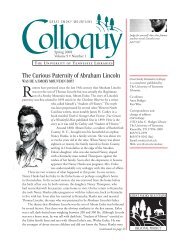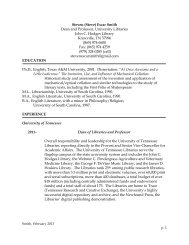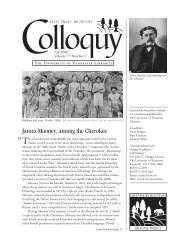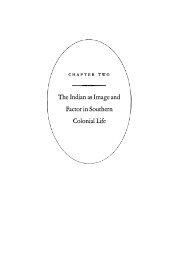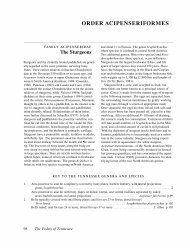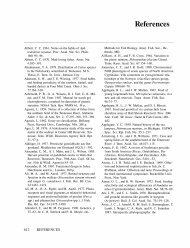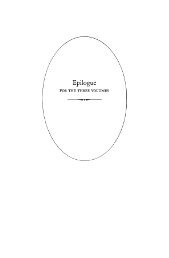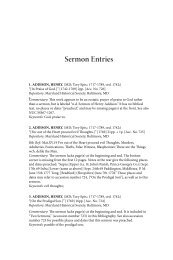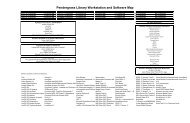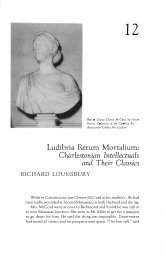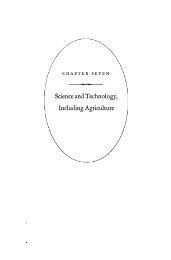Literature, Principally Belletristic - University of Tennessee, Knoxville
Literature, Principally Belletristic - University of Tennessee, Knoxville
Literature, Principally Belletristic - University of Tennessee, Knoxville
Create successful ePaper yourself
Turn your PDF publications into a flip-book with our unique Google optimized e-Paper software.
· <strong>Literature</strong>,<br />
<strong>Principally</strong> <strong>Belletristic</strong> .<br />
zette <strong>of</strong> December 30, 1729, and reprinted in the Pennsylvania Gazette<br />
<strong>of</strong> January 13 following. This is a rather impressive history <strong>of</strong> shipbuilding<br />
culminating, naturally, here in the New World. The ship itself is described,<br />
and the major Maryland river deities gather to hear Chesapeake, their<br />
monarch : "Fair Severn first appeared to grace his Court / Patuxent next<br />
did to his King resort," and so on with Chester, Patapsco, Sassafras, and<br />
"Susquehana." Then Chesapeake advises Maryland planters how to supervise<br />
the selling <strong>of</strong> their tobacco in England.<br />
What has been called with good reason the most effective neoclassical<br />
poem <strong>of</strong> colonial America is "A Journey from Patapseo to Annapolis,<br />
April 4, 1730, " which probably appeared first in a Maryland newspaper<br />
in 1730 and ceratinly in the Pennsylvania Gazette <strong>of</strong> May 21, 1731. This<br />
is a journey poem which is meditative and pastoral, and at times almost<br />
dazzling in its nature imagery. Lewis sent a copy to botanist Peter Collinson,<br />
and it soon found its way into English magazines in 1732 and 1733, appearing<br />
at least five times, including once in the Gentleman's Magazine<br />
and twice in the Weekly Register. Evidently it was as much appreciated in<br />
Britain as any other colonial poem <strong>of</strong> the period.<br />
The Pennsylvania Gazette prose introduction (probably taken from a<br />
lost issue <strong>of</strong> the Maryland Gazette ) calls the poem "an agreeable Description<br />
<strong>of</strong> Spring in these Parts <strong>of</strong> America," with the comment "The religious<br />
Turn given the whole, is suitable to the ancient Use and first Design <strong>of</strong><br />
Verse." Then follows a Latin quotation from Virgil's Georgies. The first<br />
lines <strong>of</strong> the poem are conventional and British enough, though quite soon<br />
New World topography and flora become part <strong>of</strong> the narration.<br />
At length the wintry horrors disappear;<br />
And APRIL views with smiles the infant year;<br />
The grateful earth from frosty chains unbound<br />
Pours out its vernal treasures all around . . . .<br />
In this s<strong>of</strong>t season, e'er the dawn <strong>of</strong> day,<br />
I mount my horse, and lonely take my way,<br />
From woody hills that shade Patapsco's head ...<br />
Down to Annapolis, on that smooth stream<br />
Which took from fair Anne-Arundel its name.<br />
This is not Chaucer's road to Canterbury the persona is following, but the<br />
poet produces a series <strong>of</strong> fine descriptive images <strong>of</strong> the natural world<br />
through which his traveler wanders, with sunlight filtered through the<br />
pines, mist rising from a salt marsh, the domestic animals rousing with<br />
the break <strong>of</strong> day. The sylvan beauties <strong>of</strong> the landscape kindle poetic flames<br />
in praise <strong>of</strong> the Creator. Then comes the first extensive description <strong>of</strong><br />
American wildflowers in our poetry-Pacone, Crowfoot, "Cinque-foil, with



